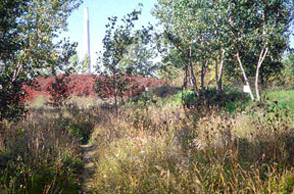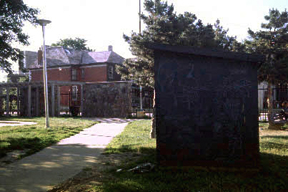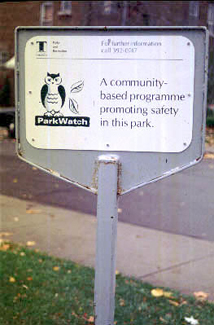A biweekly newsletter with public space news, resources, and opportunities.
A curated dispatch on all things public markets plus the latest announcements from the Market Cities Program.
Excerpted from Planning, Designing and Maintaining Safer Parks, produced by Toronto Parks & Recreation. This guide is not intended to be a definitive statement on creating safer parks and open spaces, nor is it intended to serve as a template for the design, operation and use of parks.
The design of a park can have a direct impact on people's perceptions of safety and their willingness to use a space. The physical characteristics which park users associate with high-risk environments include:
Designing a park for safety is based on what is generally considered to be good design: it meets the needs of its users; it is diverse and interesting; it connects people with place; and it provides people with a positive image and experience. While good design will not necessarily eliminate perceptions of fear or opportunities for crime to occur, it can create the preconditions for effective control.
The essence of the "eyes on the street" approach to planning and design is to increase the opportunities for informal surveillance and reduce the number of isolated places where crime can take place unseen. But, while people feel safer when they can be seen and heard by others, it would be difficult and possibly undesirable to achieve this at all times, in all types of park settings. For example, naturalized parks can be visually and aurally isolated places yet one study found that a diverse landscape of tall grass meadows, shrub thickets and woodlands was not only the most feared but also the most valued (Burgess et al., 1988) This paradox presents an interesting challenge: How can natural areas be planned in a manner which mitigates the apprehension and isolation associated with them? Experience has shown that no one solution prevails. What is vitally important is to provide choices and information so that users can make informed decisions. Safety should be a primary consideration along main routes through parks and between the park perimeter and the street. In more isolated natural areas, possible dangers should be recognized by means of clear signage and legible layouts which direct people toward more heavily populated areas but do not remove the freedom for users to explore alternative routes if they wish. What to consider:
Supporting Park Activity
Informal Surveillance
Balancing "Negative" Land Uses
Intensify Activity to Reduce Isolation
Access to Assistance

Legibility refers to the clarity of the environment. It has been described as, the degree to which a space is understandable; the ease with which its parts can be recognized and organized into a coherent pattern (Lynch, 1960). When a park is legible, users are able to form clear, accurate images of it. An ability to find one's way with ease, contributes to a sense of security and comfort. Conversely, feelings of being unsafe increase as chances for getting oriented are reduced or if familiar landmarks or points of reference are absent. Legibility is also vital for efficient pedestrian circulation as legible pathways convey a sense of easy access, of clear direction and of well-defined boundaries. What to consider:
Enhancing Site Legibility

Visibility is an important factor in enhancing park users' feelings of comfort and security. Perceptions of safety increase markedly if people can see ahead and around them, and if other people are visible. Clear sightlines allows park users to ability to verify the presence of persons which they might find threatening. The ability to see into and out of an area is referred to as visual permeability. The presence of shrubbery, fences, walls, sharp corners, storage sheds or buildings can hinder visibility and thus reduce perceived and actual safety. The degree of visibility that is appropriate has to be evaluated on the basis of the scale, function, context and user group of a park. Small neighbourhood and downtown parks usually feel more comfortable if a considerable degree of openness is provided. In larger parks, clear sightlines along the frequently used pedestrian routes, between activity areas and along park edges are also important.
Regardless of park size, safety begins at the perimeter. If the perimeter is inviting and people can observe pleasing activity from the street, they are more inclined to enter a park (Whyte, 1981). An active and visible edge will encourage use and create a perimeter of surveillance for the park. An active edge can also increase park accessibility to user groups who may feel more vulnerable in the park interior and who are of lower mobility, such as women, children, older adults and people with disabilities. What to consider:
Creating an Active Edge
Legible Entrances
Encouraging Surveillance
Improving Sightlines
Future Sightline Barriers
Safety can be enhanced by providing users with a choice of entrances and exits as well as routes to and from areas. The extent to which an environment allows people alternative choices of movement on a site is referred to as physical permeability (Bentley et al., 1985). A choice of direct and attractive routes will maximize legibility and physical accessibility. Alternatively, the absence of a legible and efficient circulation system may discourage use altogether or lead to a number of "dead" areas that are likely to become deserted creating an important precondition for undesirable activities to occur. Alternative routes provide:
An opportunity to bypass areas perceived as threatening: A pathway that forces women to walk through an area dominated by adult men or teenaged boys may create anxiety and unease if no other routes are provided. Users must be aware of the alternative routes if their freedom of choice is to be meaningful.
An opportunity to avoid movement predictors: Channelized routes, also known as "movement predictors", can be problematic because they create an opportunity for a potential attacker to calculate a person's movement pattern and to predict their destination. Movement predictors can be especially hazardous in isolated areas.
An opportunity to avoid entrapment areas: Park users need to know it is possible to move into and out of the park without being trapped. An "entrapment" area is any area enclosed on three sides. What to consider:
Physical Accessibility
Design of Primary Routes
Location of Primary Routes
Evening Use
Principal routes to nighttime activity nodes should be clearly identified and their use encourage. These nighttime corridors should be properly illuminated with good visibility to increase the chance of informal and formal surveillance.
Channelized Routes/Movement Predictors
Through Circulation
Maintenance
The single most requested physical design modification to improve safety is usually an increase in lighting. Lighting is a key factor because it can clarify the layout of a park by emphasizing walkways, focal points, gathering places and building entrances. When planned as a coordinated system, lighting improves the night time legibility, use and enjoyment of a site. Lighting, like signage, is best developed as a hierarchy. The top of the hierarchy includes lighting activity areas and primary walkways so that they become the focus of pedestrian activity after dark. At the bottom of this hierarchy is the decision not to light some areas at all because their use at night would be unsafe or inappropriate. While lighting has been shown to reduce people's fear of crime (Middlesex, 1989), lighting alone is not the sole solution to safety-related issues. If increased park use does not result following lighting upgrades, people may feel safe in areas which are potentially unsafe. What to consider:
Hierarchy of Lighting Types and Intensities
Enhancing Edge Activities
Placement of Lighting
Consistency of Lighting
Inappropriate Lighting
Encouraging Evening Use
Co-ordination with Signage
Further discussion: The design of lighting in many urban parks is the responsibility of road engineers and too often it is designed for road traffic instead of for pedestrian movement. The illumination standard set for pedestrian walkways, by the Canadian Standards Association, is 0.4 footcandles. Put another way, at this standard a person's face can be identified from 12 to 15 metres away. In addition to adequate illumination levels, a consistent level of lighting with minimal glare is required. Strong, uneven lighting can create crimes of opportunity because users and police focus on the lit areas, but fail to notice activity in the shadows. As well as enhancing the safety image of a park, lighting can be used to increase the publicness of such places by providing a greater range and choice of time in which the park is accessible for use.

The most successful park spaces offer some degree of diversity in their physical features, activities and users. Such diversity implies interest, pleasure, stimulated senses and varied landscapes (Hough, 1984).
Efforts to improve safety that involve the extensive removal of vegetation of reduction in the diversity of park environments are unlikely to result in safer places. This sterilization of the landscape will more likely result in less frequent use. Instead, diversity should be used to attract and sustain use throughout the seasons. A visual richness that includes variety in the form, colour and texture of landscape elements as well as a mix of user groups is likely to result in attractive environments and frequent use. What to consider:
Diversity in the Physical Environment

Signage is a critical component in promoting park safety because people feel safer when they know where they are and how to get to where they want to go. Signs, like lighting, are most effective when developed as a hierarchy: a system of coordinated and complimentary signs will provide a sense of order and clarity as well as improve the perception of safety in a park. Instead of focusing on restrictive messages that begin with "Do Not ...", a more constructive approach is to use signage as a tool to encourage a sense of ownership and pride among user groups. To achieve this, signage should be positive, informative and encourage people to enjoy themselves. Signage can also be used as a tool to educate users about security issues and to encourage them to report suspicious activity. As many crimes are witnessed by people who neither report them nor intervene, signage and information brochures can encourage more direct citizen involvement in keeping parks safe. What to consider:
Location of Signage
Design of Signage
Content of Signage and Park Brochures
Primary Routes
Evening Use
Maintenance
Accessible and easily locatable, public telephones are a high priority. Telephones are not only a matter of convenience, but they also act as a symbol of safety and security as do visible police patrols and a high level of maintenance. The presence of parks staff play a similar role by providing a sense that help is available, if required. What to consider:
Telephone Location
Telephone Design
Telephone Identification
Co-ordination of Telephone, Signage and Lighting
Cell Telephones
Formal Surveillance
The rich text element allows you to create and format headings, paragraphs, blockquotes, images, and video all in one place instead of having to add and format them individually. Just double-click and easily create content.
The rich text element allows you to create and format headings, paragraphs, blockquotes, images, and video all in one place instead of having to add and format them individually. Just double-click and easily create content.
Body Text Body Link
The rich text element allows you to create and format headings, paragraphs, blockquotes, images, and video all in one place instead of having to add and format them individually. Just double-click and easily create content.
Here is some highlighted text from the article.




Headings, paragraphs, blockquotes, figures, images, and figure captions can all be styled after a class is added to the rich text element using the "When inside of" nested selector system.
Headings, paragraphs, blockquotes, figures, images, and figure captions can all be styled after a class is added to the rich text element using the "When inside of" nested selector system.
Headings, paragraphs, blockquotes, figures, images, and figure captions can all be styled after a class is added to the rich text element using the "When inside of" nested selector system.

We are committed to access to quality content that advances the placemaking cause—and your support makes that possible. If this article informed, inspired, or helped you, please consider making a quick donation. Every contribution helps!
Project for Public Spaces is a 501(c)(3) tax-exempt organization and your donation is tax-deductible within the guidelines of U.S. law.